Mad respect madpenguin! I am in now way advocating that anyone do this on their own. I like to know how things work and like to take things apart and put them back together. It is cool to know your light plugs into an outlet but how does it really work??? Knowing how electricity works and how things are wired up and better yet, RESPECTING it, could save your life one day. We were poor growing up so all the household things got fixed by family. I learned from family in the trades. Yes I keep a copy of the NEC and yes, I obey it, everyone should. There are some items and areas that people don't want to hire an electrician for and I would rather them know the PROPER way to do things then try to half ass it and damage themselves or others. You knowledge is appreciated and your input is more then welcome. Thanks!
-
ICMag with help from Phlizon, Landrace Warden and The Vault is running a NEW contest for Christmas! You can check it here. Prizes are: full spectrum led light, seeds & forum premium access. Come join in!
You are using an out of date browser. It may not display this or other websites correctly.
You should upgrade or use an alternative browser.
You should upgrade or use an alternative browser.
Growroom Electricity and Wiring
- Thread starter Phillthy
- Start date
Y
yamaha_1fan
And since we are now on the subject, I might as well throw this out in the open before the thread progresses too much farther.
If anyone has any doubts as to how to wire something correctly, then just don't do it.
I have a real problem with some folks around here giving advice as to dismantling ballasts, transformers, variacs and the like. I don't mean to belittle anyone on this forum, but that is way beyond the ability of the average person. I realize a lot of you are technically inclined and can do such things but to give such advice and word it like it's no big deal is morally and ethically wrong. I will not be responsible for the death of any member here so I will never tell someone how to do such things. My answer will, and always will be, "return it". And on a much lesser note, you void your warranty when you do stuff like that. You paid good money for your equipment so just return the damn thing. You shouldn't be expected, as a consumer, to have to service your own electrical equipment.
In fact, I should probably quit posting electrical related topics all together. Electricity is nothing to take lightly. People under estimate residential voltage all the time. The current that a 60w light bulb draws will kill you in a heart beat. Period. If the path crosses your heart, kiss your ass goodbye. Even if it doesn't cross your heart, but you manage to get "hung up", kiss your ass goodbye.
Also, you guys should understand my frame of mind. Yes, I'm an electrician. I love my job. I don't do it for the money. I do it because I thoroughly enjoy working with electricity. I'm an anal son-of-a-bitch and I take longer to do something than your average electrical contractor. Why? Because I do things the right way, not the quick way. If your really good, you can balance both (which I have a hard time doing). Thus, I no longer sub anymore but just work for a company.
So, being the way that I am, The National Electrical Code is scripture to me. Every article in the NEC was put there because someone died. Back in the early 1900's it was a very thin book. Look at how big it is now. So, actually, me telling anyone "unqualified" (yes, it's defined in the NEC) to do work without a permit is morally and ethically wrong. The shit needs to be inspected. If you own your own home, many jurisdictions will allow the home owner to pull a permit. If you live in an apartment, you really should not be doing the work yourself. You make a mistake and you kill everyone in the building. Could you live with yourself if you made a mistake wiring your grow room and your next door neighbors 4 year old daughter burned alive in her bed? Not me.
Or get this.... Say member "kindbud69" received some advice here to swap out the capacitor on his 1000w ballast. "O.K... Sounds easy enough". So kindbud69 goes down in the basement to his grow room to get the ballast. Since he enjoys being in his grow room, he gets a chair and a collapsible TV dinner table and decides to do the work there. Chillin with the plants on a lazy Sunday afternoon, gonna fix my ballast, life is good. Set's the ballast on the table. Takes the housing off. Correctly identifies the capacitor and starts to remove it.
BAM
Kindbud69 is now laying on the floor in cardiac arrest. Too bad joeschmoe589 forgot to mention that the capacitor could very well be charged still. Even more of a shame that kindbud69 had a small hole in his left shoe sole. Worse yet, kindbud69 spilled some water when topping off his res an hour earlier and happened to have his left foot sitting on a wet and grounded surface (concrete floor).
Too bad joeschmoe589 will never know that he indirectly just killed someone. Look at the last line in my sig and ignore the smiley face. It's probably the best thing you can do if you have any hesitation as to how to do something.
Sorry for the book but I take it very seriously and you guys should to. Also, if it's not obvious yet, any and all advice that I give is based upon 120/240v 60hz American electrical systems. If you live in Europe or anywhere else (most of the world) that deals with different voltages or frequencies, then you probably shouldn't be listening to me.
Thats cool and all if I was wiring up my new hottub. But the fact is most of us cant bring in an electrician if we wanted to. I have learned alot about electricity on this forum. I also have a BIL who is a journyman that I can discuss things with and get advice. But hes 800 miles away so I cant get him to do any work. Point is alot of people on this forum get alot of help from people on this forum.
i do agree that people should be more cautious giving advice on electrical matters. I chime in sometimes but only on matters I know and give a warning to wait for people like Pharmacan or CocktailFrank to respond
Back-X-ing
Member
Thank God. This is by far the most useful info i have ever came across on this forum. The Hardest part for me and people alike is electrical work. I thank you. The graphs and reply are sweet. i would love to see more.
G
Guest 18340
Right on Phillthy! Im permanently book marking this thread.
Maybe someone can post pics/explain the wiring of a breaker box, how to properly install a breaker, how to wire it, etc.
Maybe someone can post pics/explain the wiring of a breaker box, how to properly install a breaker, how to wire it, etc.
Bozo
Active member
Problems pop up when people dont follow wire ratings and breaker recomendations .ie 12 gauge wire 30 amp breaker .Back stabbing is a huge no no I dont recomend it even on spec grade recepticals.Yeah its more work but worth it .Make sure the loops in your wires are hooked in same direction as the screw will turn (clockwise) .This way the hook tightens around screw as you tighten .Wire nut connections need to tight not kinda tight .If you arent possitive it is a good connection tug on it and tighten it little more .
I like to work on panels that are live keeps you on yer toes .My favorite is turning on breaker on before you wire in recepticals .That way if you catch the ground with your lineman pliers you arch out a nice little notch for stripping .(just kidding about the arching of pliers those are expensive and I use em to tie rebar )
We cant call eletricians that is sad but true .If we could there wouldnt be so many grow house fires in Ca...
If you dont know what to do the best thing to do is have a electrician in before you set up .Just tell him what you want and leave him to his workn .
I want a dedicated 20 amp outlet there and one there and a 40 amp 240 outlet here and here is the male end I will use .Who cares what excuse you use most sparkys will know wtf yer doing .In this economy they are glad to have work dout they will question it .If they ask tell them it is a room you use to film porm its for the equipment .Dout he will want more info than that
I like to work on panels that are live keeps you on yer toes .My favorite is turning on breaker on before you wire in recepticals .That way if you catch the ground with your lineman pliers you arch out a nice little notch for stripping .(just kidding about the arching of pliers those are expensive and I use em to tie rebar )
We cant call eletricians that is sad but true .If we could there wouldnt be so many grow house fires in Ca...
If you dont know what to do the best thing to do is have a electrician in before you set up .Just tell him what you want and leave him to his workn .
I want a dedicated 20 amp outlet there and one there and a 40 amp 240 outlet here and here is the male end I will use .Who cares what excuse you use most sparkys will know wtf yer doing .In this economy they are glad to have work dout they will question it .If they ask tell them it is a room you use to film porm its for the equipment .Dout he will want more info than that
madpenguin
Member
Yea, I realize you can't have an electrician come in while the op. is in progress... With proper planning, all the wiring should be done before hand. Even then, upgrades are sometimes necessary. So this is why we do it ourselves.
I have no problem with standard wiring procedures being done by homeowners. It's really quite easy once you get the basics down. It's when you start dealing with motor controls, ballasts et. all that a "qualified" person should be doing the work. Again, just make sure you know what your doing beforehand.
Terminology: (sorry for the basics)
Neutral = grounded conductor
Hot = ungrounded conductor
Ground = grounding conductor
conductors = individual wire
cable = An entire assembly of multiple conductors jacketed with an outer sheath.
AL = aluminum
CU = copper
OCPD = Over Current Protection Device (a.k.a circuit breaker)
Conductor ampacities (Table 310.16)
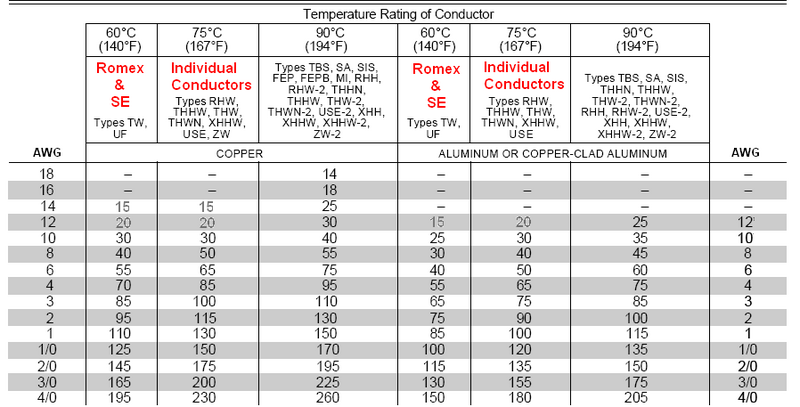
I've slightly modified 14 and 12 gauge to fit residential applications so this table isn't verbatim from the NEC. Look at the 6 gauge CU ampacity for romex. Says 55 amp. The NEC allows you to bump up to 60A since there is no 55A OCPD (good luck finding one anyway). Same with 4/0 CU (pronouced four aught). That's good for 200A. But look at #3 CU. Don't use that for 100A. Only round by 5 if there is no breaker that matches the ampacity. You would need to use #2 CU or 1/0 AL for 100A feeder.
The 75 degree column is for using individual conductors only (the ones listed). They must be run in conduit. You can also only have 3 current carrying conductors in a raceway (conduit). If you have more, you need to start de-rating the wire. I won't go into that. The grounded (neutral) conductor counts as a current carrying conductor but the grounding conductor does not.
Remember to do your Voltage Drop calculations before running feeders for sub-panels or branch circuits coming out of panels. Don't exceed 3% for feeders and 2% for the branch circuits. A total of 5% from your main panel to the point-of-use.
Pretty sure I mentioned this before, but always use copper wire. The only time you should be using aluminum is for large feeder cables that power a sub-panel. When you do use AL, you must use anti-oxidant compound on your connections. It's a dark grey goop that comes in a tube. If you don't, over time, the wire will oxidize and start to look like your battery terminals on a car. White crusty crap every where. This shoots resistance thru the roof and AL already has a higher resistance than CU. Any time you have a high resistance, you get heat, which isn't good. Make sure you use the correct columns in the chart above for CU and AL ampacities. When applying anti-oxidant compound, don't get crazy with it. Just enough to evenly coat the entire exposed part of the AL conductor.
All Romex or NM-B cable is rated for 60 Celsius. The individual conductors are rated at 90 degrees but the cable assembly is rated at 60. This is your typical cable you buy for your house. Shown is a roll of 12/2 with ground.
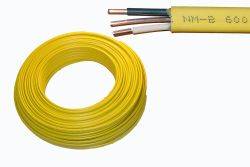
MC (metal clad) cable is also applicable for 60 Celsius. It has a green sheathed grounding conductor.
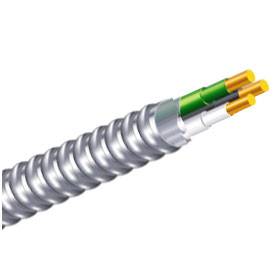
AC cable is also rated at 60 Celsius: Notice the grounding conductor is AL and not sheathed. It is in contact with the outer metal jacket. Most places will only sell Type MC cable (which is what you should use instead of AC). Also notice the anti-short bushings (a.k.a redheads). Use them for both Type MC and AC cable. They protect the conductor insulation from being damaged on the cut rough edges of the metal jacket.
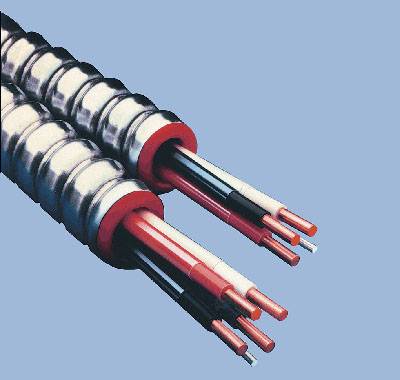
SEU cable is also rated at 60 Celsius. These should only be used to feed your main panel coming from your meter. Thus, you will never use it because you shouldn't be inside your meter anyway.:wink: Not a very good pic. Notice it has two sheathed ungrounded conductors, then around those, you will find individual strands of AL wire. These are to be twisted together to form an uninsulated grounded (neutral) conductor. There is no grounding conductor in this cable.
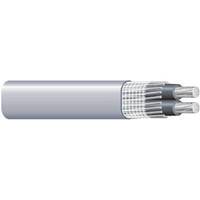
Type SER is also rated at 60 Celsius. This is what you would use to feed a panelboard (a.k.a sub panel). This is copper but will typically come in AL, just like SEU cable. It has 2 ungrounded conductors. One should be all black, the other all black with a red stripe. There will also be a sheathed grounded (neutral) conductor. It will typically be all black with a white stripe. Then you'll have an uninsulated grounding conductor.

When feeding sub-panels, you need to use SER cable. All grounded (neutrals) and grounding (grounds) conductors need to be isolated in a sub-panel. If you guys look at your main panel, you'll probably see both grounds and neutrals terminated to the same buss bar. Don't do this in a sub-panel.
Here is a MLO panelboard (Main Lug Only sub-panel) fed with, what looks to be 6 or 8 gauge romex. If it's #6 CU romex, then you have to use no larger than a 60A double pole breaker in your main panel. If it's #8 CU romex, then no larger than a 40A double pole breaker in your main panel.
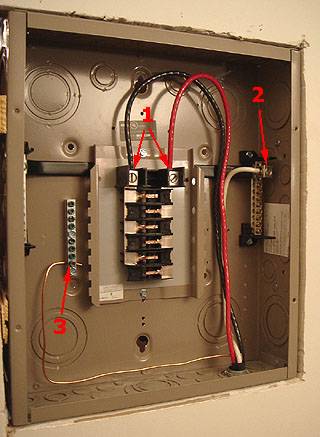
1. The ungrounded conductors (red and black) are connected to the top 2 main lugs which in turn feed the hot buss bars.
2. The grounded conductor (white) is connected to the large lug on the neutral buss bar. The neutral buss will be isolated from the frame of the panel. Notice this panelboard has 2 neutral buss, the other one is hiding to the left.
3. The grounding conductor (no sheathing) is connected to the ground buss. This will be directly fastened to the panel frame. Some panelboards don't come with a dedicated ground buss. You must purchase and install it separately if not. I also don't like the location of that ground buss. Too close to the hot and neutral buss. I would have put it down below.
Here's a close up of the isolated neutral buss:
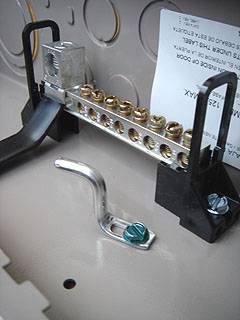
Notice the bonding bar with the green screw. Remove this entirely. Some panelboards will come with a thin bonding strap, others will come with a long green grounding screw. It's to bond the neutral bus to the frame of the panel if you are using the panelboard as a main panel. In that case, you would loosen the screw, rotate the bar to the right and put it under one of the terminals on the neutral buss, then tighten down both screws. Don't do this on a sub-panel.
Breakers:
Make sure you purchase the correct circuit breaker for the panel you are using. There is "Square-D type QO", "Siemens type QP", "Cuttler-Hammer type BR" and so on, and so on.... It's paramount you use the correct manufacturers breaker.
Here is a single pole 120v circuit breaker. Used to feed branch circuit 120v loads.
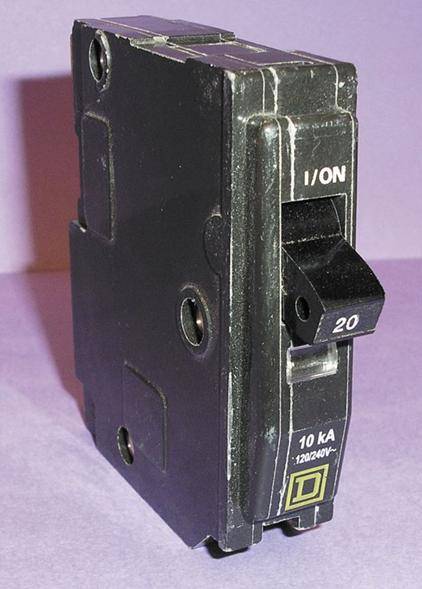
Here is a double pole 240v circuit breaker. Used to feed 240v branch circuits and feeder cables to sub panels:
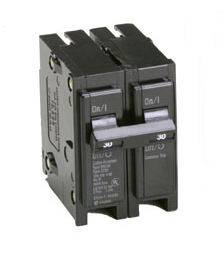
Here is a tandem breaker. It fits in a single slot but is designed to feed 2 - 120v loads. Do not use this to feed a 240v load. For 240v loads, the breaker needs to pull from both hot legs that feed the panel (red and black feeder conductors). This breaker only pulls from one of the hot legs supplying the panel. Both hot conductors for 240v also need to have a common trip, meaning the handles need to be joined. Here they are not. You would also want to read the spec sheet for your panelboard and see if it is rated for tandem breakers. I don't really condone the use of them, but, if they are allowed to be used in the panel, it's a good way to free up space for an extra circuit (if your panel is full). Just don't get crazy with them.
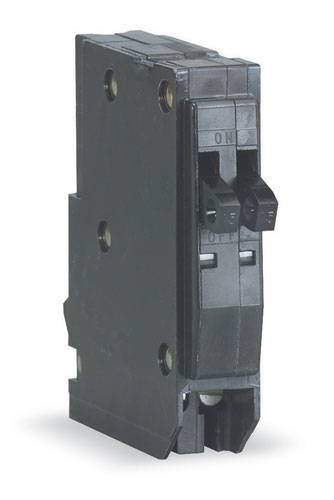
Back to the panelboard.... Make up your connections in the panelboard before you tie in the feeder cable at the main panel. That's common sense. Once that is done, go back to your main panel and tie in the feeder you just ran to the panelboard. You want to use a double pole 240v circuit breaker. This means you need 2 free spaces in your main panel to power your sub panel.
When ever you make connections anywhere, always do it in this order. Connect your ground first. Then connect your neutral, then connect your hot last. When taking a connection apart, reverse the order. Hot, neutral, ground.
So, to connect the feeder cable in your main panel, attach your grounding wire first. This will more than likely get terminated to your neutral buss in the main panel as will the neutral wire of our feeder like so:
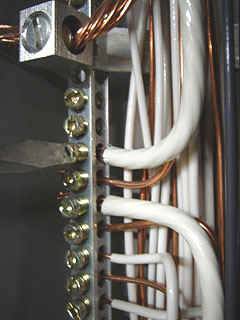
If your neutrals and grounds are separated in your main panel, this likely means you have an outside disconnect right below the meter. That means your main panel is actually a sub-panel!!! If that's the case, then you would tie the ground wire for your new sub-panel feed onto the isolated ground buss in your main panel.
Hope I didn't loose anyone there.But... If all your neutrals and grounds are terminated to the same buss bar in your main panel, both the neutral and ground of your sub-panel feed get terminated to your main panels neutral buss bar as the pic above shows.
When terminating wires to lugs, you really need to torque them down good. Some times the panel/equipment will list the torque specifications, other times it won't. Just tighten them down good. Typically, with a #14 ground wire, I'll wind up crushing them to about 2/3rds of their original diameter. If you've tightened them down to the point where you've reduced the diameter in half, then your tightening too much.
Then take your left over 2 hot conductors for the feeder cable, and attach each one to the double pole circuit breaker. There will be 2 screws on the breaker. One for each wire.
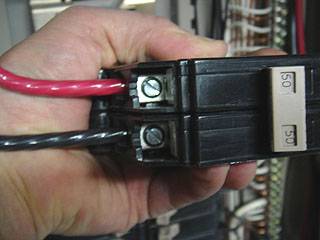
Once the screws have been torqued down on the breaker, make sure the breaker is in the "off" position and then snap it onto the hot buss bars of your main panel. If this makes you nervous, then throw your main breaker to kill the entire panel before you do so. In fact, I recommend that anyone kill the main breaker before they even take the cover off. Don't take chances. You can buy battery powered ball caps at Lowes or Home Depot.... :wink: That or the head lamps.
Breakers will attach in various ways to the hot buss of your panel. Study the breaker and around the hot buss on your panel. Usually, the "screw side" of the breaker will have little hooks and you can see a place for them on your panel. Put those in first and then push down on the breaker to make a connection with the hot buss.
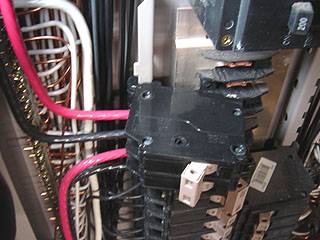
Turn your main breaker back on but leave the double pole breaker that feeds your new sub-panel "off". Don't power that up until you've ran your branch circuits out of the sub-panel.
That burned me out but I can post later with pics on how to install branch circuits....
I have no problem with standard wiring procedures being done by homeowners. It's really quite easy once you get the basics down. It's when you start dealing with motor controls, ballasts et. all that a "qualified" person should be doing the work. Again, just make sure you know what your doing beforehand.
Terminology: (sorry for the basics)
Neutral = grounded conductor
Hot = ungrounded conductor
Ground = grounding conductor
conductors = individual wire
cable = An entire assembly of multiple conductors jacketed with an outer sheath.
AL = aluminum
CU = copper
OCPD = Over Current Protection Device (a.k.a circuit breaker)
Conductor ampacities (Table 310.16)
I've slightly modified 14 and 12 gauge to fit residential applications so this table isn't verbatim from the NEC. Look at the 6 gauge CU ampacity for romex. Says 55 amp. The NEC allows you to bump up to 60A since there is no 55A OCPD (good luck finding one anyway). Same with 4/0 CU (pronouced four aught). That's good for 200A. But look at #3 CU. Don't use that for 100A. Only round by 5 if there is no breaker that matches the ampacity. You would need to use #2 CU or 1/0 AL for 100A feeder.
The 75 degree column is for using individual conductors only (the ones listed). They must be run in conduit. You can also only have 3 current carrying conductors in a raceway (conduit). If you have more, you need to start de-rating the wire. I won't go into that. The grounded (neutral) conductor counts as a current carrying conductor but the grounding conductor does not.
Remember to do your Voltage Drop calculations before running feeders for sub-panels or branch circuits coming out of panels. Don't exceed 3% for feeders and 2% for the branch circuits. A total of 5% from your main panel to the point-of-use.
Pretty sure I mentioned this before, but always use copper wire. The only time you should be using aluminum is for large feeder cables that power a sub-panel. When you do use AL, you must use anti-oxidant compound on your connections. It's a dark grey goop that comes in a tube. If you don't, over time, the wire will oxidize and start to look like your battery terminals on a car. White crusty crap every where. This shoots resistance thru the roof and AL already has a higher resistance than CU. Any time you have a high resistance, you get heat, which isn't good. Make sure you use the correct columns in the chart above for CU and AL ampacities. When applying anti-oxidant compound, don't get crazy with it. Just enough to evenly coat the entire exposed part of the AL conductor.
All Romex or NM-B cable is rated for 60 Celsius. The individual conductors are rated at 90 degrees but the cable assembly is rated at 60. This is your typical cable you buy for your house. Shown is a roll of 12/2 with ground.
MC (metal clad) cable is also applicable for 60 Celsius. It has a green sheathed grounding conductor.
AC cable is also rated at 60 Celsius: Notice the grounding conductor is AL and not sheathed. It is in contact with the outer metal jacket. Most places will only sell Type MC cable (which is what you should use instead of AC). Also notice the anti-short bushings (a.k.a redheads). Use them for both Type MC and AC cable. They protect the conductor insulation from being damaged on the cut rough edges of the metal jacket.
SEU cable is also rated at 60 Celsius. These should only be used to feed your main panel coming from your meter. Thus, you will never use it because you shouldn't be inside your meter anyway.:wink: Not a very good pic. Notice it has two sheathed ungrounded conductors, then around those, you will find individual strands of AL wire. These are to be twisted together to form an uninsulated grounded (neutral) conductor. There is no grounding conductor in this cable.
Type SER is also rated at 60 Celsius. This is what you would use to feed a panelboard (a.k.a sub panel). This is copper but will typically come in AL, just like SEU cable. It has 2 ungrounded conductors. One should be all black, the other all black with a red stripe. There will also be a sheathed grounded (neutral) conductor. It will typically be all black with a white stripe. Then you'll have an uninsulated grounding conductor.
When feeding sub-panels, you need to use SER cable. All grounded (neutrals) and grounding (grounds) conductors need to be isolated in a sub-panel. If you guys look at your main panel, you'll probably see both grounds and neutrals terminated to the same buss bar. Don't do this in a sub-panel.
Here is a MLO panelboard (Main Lug Only sub-panel) fed with, what looks to be 6 or 8 gauge romex. If it's #6 CU romex, then you have to use no larger than a 60A double pole breaker in your main panel. If it's #8 CU romex, then no larger than a 40A double pole breaker in your main panel.
1. The ungrounded conductors (red and black) are connected to the top 2 main lugs which in turn feed the hot buss bars.
2. The grounded conductor (white) is connected to the large lug on the neutral buss bar. The neutral buss will be isolated from the frame of the panel. Notice this panelboard has 2 neutral buss, the other one is hiding to the left.
3. The grounding conductor (no sheathing) is connected to the ground buss. This will be directly fastened to the panel frame. Some panelboards don't come with a dedicated ground buss. You must purchase and install it separately if not. I also don't like the location of that ground buss. Too close to the hot and neutral buss. I would have put it down below.
Here's a close up of the isolated neutral buss:
Notice the bonding bar with the green screw. Remove this entirely. Some panelboards will come with a thin bonding strap, others will come with a long green grounding screw. It's to bond the neutral bus to the frame of the panel if you are using the panelboard as a main panel. In that case, you would loosen the screw, rotate the bar to the right and put it under one of the terminals on the neutral buss, then tighten down both screws. Don't do this on a sub-panel.
Breakers:
Make sure you purchase the correct circuit breaker for the panel you are using. There is "Square-D type QO", "Siemens type QP", "Cuttler-Hammer type BR" and so on, and so on.... It's paramount you use the correct manufacturers breaker.
Here is a single pole 120v circuit breaker. Used to feed branch circuit 120v loads.
Here is a double pole 240v circuit breaker. Used to feed 240v branch circuits and feeder cables to sub panels:
Here is a tandem breaker. It fits in a single slot but is designed to feed 2 - 120v loads. Do not use this to feed a 240v load. For 240v loads, the breaker needs to pull from both hot legs that feed the panel (red and black feeder conductors). This breaker only pulls from one of the hot legs supplying the panel. Both hot conductors for 240v also need to have a common trip, meaning the handles need to be joined. Here they are not. You would also want to read the spec sheet for your panelboard and see if it is rated for tandem breakers. I don't really condone the use of them, but, if they are allowed to be used in the panel, it's a good way to free up space for an extra circuit (if your panel is full). Just don't get crazy with them.
Back to the panelboard.... Make up your connections in the panelboard before you tie in the feeder cable at the main panel. That's common sense. Once that is done, go back to your main panel and tie in the feeder you just ran to the panelboard. You want to use a double pole 240v circuit breaker. This means you need 2 free spaces in your main panel to power your sub panel.
When ever you make connections anywhere, always do it in this order. Connect your ground first. Then connect your neutral, then connect your hot last. When taking a connection apart, reverse the order. Hot, neutral, ground.
So, to connect the feeder cable in your main panel, attach your grounding wire first. This will more than likely get terminated to your neutral buss in the main panel as will the neutral wire of our feeder like so:
If your neutrals and grounds are separated in your main panel, this likely means you have an outside disconnect right below the meter. That means your main panel is actually a sub-panel!!! If that's the case, then you would tie the ground wire for your new sub-panel feed onto the isolated ground buss in your main panel.
Hope I didn't loose anyone there.But... If all your neutrals and grounds are terminated to the same buss bar in your main panel, both the neutral and ground of your sub-panel feed get terminated to your main panels neutral buss bar as the pic above shows.
When terminating wires to lugs, you really need to torque them down good. Some times the panel/equipment will list the torque specifications, other times it won't. Just tighten them down good. Typically, with a #14 ground wire, I'll wind up crushing them to about 2/3rds of their original diameter. If you've tightened them down to the point where you've reduced the diameter in half, then your tightening too much.
Then take your left over 2 hot conductors for the feeder cable, and attach each one to the double pole circuit breaker. There will be 2 screws on the breaker. One for each wire.
Once the screws have been torqued down on the breaker, make sure the breaker is in the "off" position and then snap it onto the hot buss bars of your main panel. If this makes you nervous, then throw your main breaker to kill the entire panel before you do so. In fact, I recommend that anyone kill the main breaker before they even take the cover off. Don't take chances. You can buy battery powered ball caps at Lowes or Home Depot.... :wink: That or the head lamps.
Breakers will attach in various ways to the hot buss of your panel. Study the breaker and around the hot buss on your panel. Usually, the "screw side" of the breaker will have little hooks and you can see a place for them on your panel. Put those in first and then push down on the breaker to make a connection with the hot buss.
Turn your main breaker back on but leave the double pole breaker that feeds your new sub-panel "off". Don't power that up until you've ran your branch circuits out of the sub-panel.
That burned me out but I can post later with pics on how to install branch circuits....
Last edited:
S
sparkjumper
In the codebook I passed my test with,1774lol I think 1984 article 310-16 had asterisks on the 14,12,and 10 wire.It said these conductors "shall" be protected with 15,20,and 30A OC devices.The term "shall" in the codebook means mandatory.Just curious is this still the case?
madpenguin
Member
On a side note, just to avoid any arguments with electricians here; You must use Table 310.16 to size feeders. Table 310.15(B)(6) is the most misapplied table in the NEC. The ampacity ratings are less than what you will find with 310.16....
They even altered the verbage in 2008 to say that if using 310.15(B)(6), The feeder in question has to serve all loads associated with the dwelling, which a panelboard does not (in most cases).
The intent was always there in 2005 and earlier by way of 338.10(B)(4)(A) and 334.80. So, don't use #2 AL for a 100A panelboard feeder!
Always use 310.16 for everything except for your actual service drop (in a nut shell).
They even altered the verbage in 2008 to say that if using 310.15(B)(6), The feeder in question has to serve all loads associated with the dwelling, which a panelboard does not (in most cases).
The intent was always there in 2005 and earlier by way of 338.10(B)(4)(A) and 334.80. So, don't use #2 AL for a 100A panelboard feeder!

Always use 310.16 for everything except for your actual service drop (in a nut shell).
madpenguin
Member
In the codebook I passed my test with,1774lol I think 1984 article 310-16 had asterisks on the 14,12,and 10 wire.It said these conductors "shall" be protected with 15,20,and 30A OC devices.The term "shall" in the codebook means mandatory.Just curious is this still the case?
Yes, it's still the case, which is why I removed the asterisks and changed the values. They point you to 240.4(D) which says #14 is good for 15A and #12 is good for 20A, unless specifically permitted by 240.4(E) or (G), which are tap conductors and specific applications respectively.
mikecar312
Member
When feeding sub-panels, you need to use SER cable. All grounded (neutrals) and grounding (grounds) conductors need to be isolated in a sub-panel. If you guys look at your main panel, you'll probably see both grounds and neutrals terminated to the same buss bar. Don't do this in a sub-panel.
can you explain why neutrals and ground are ok at the main panel but not ok in the sub panel? i know it has something to do with the ground being uninsulated so it shouldn't be connected to the same bus as the neutral which carries a charge. what can happen if this is done...just an electric shock every once in a while?
madpenguin
Member
You basically want to create a low impedance dedicated return path for any ground fault current if it occurs. The neutral wire of the feeder going back to the main panel should only carry the return current at all times, just as a 14/2 branch circuit neutral should only carry the return current at all times.
There should only be one point where neutral and ground are bonded together and that's typically in your main panel, or rather, at your main service disconnect (which can sometimes be outside in a separate enclosure).
On a semi related note, in most houses you have the meter outside and the main panel in the basement practically 5 feet away from the meter. The incoming SEU cable is unfused so it has to go directly into your main panel with the service disconnect, otherwise it's a potential fire hazard. If the SEU cable had to travel more than 5 feet or so inside your house, you need to have your main service disconnect outside, and then use SER from the disconnect to your "main panel". Then you would need to attach the ground rod and water meter bond to the outside disconnect instead of your panel (they would attach to the neutral in the outside disconnect).
There are many different requirements if your installing a sub-panel in a detached structure (garage, shed, barn). The above post was for a sub-panel in the same house as the main panel.
There should only be one point where neutral and ground are bonded together and that's typically in your main panel, or rather, at your main service disconnect (which can sometimes be outside in a separate enclosure).
On a semi related note, in most houses you have the meter outside and the main panel in the basement practically 5 feet away from the meter. The incoming SEU cable is unfused so it has to go directly into your main panel with the service disconnect, otherwise it's a potential fire hazard. If the SEU cable had to travel more than 5 feet or so inside your house, you need to have your main service disconnect outside, and then use SER from the disconnect to your "main panel". Then you would need to attach the ground rod and water meter bond to the outside disconnect instead of your panel (they would attach to the neutral in the outside disconnect).
There are many different requirements if your installing a sub-panel in a detached structure (garage, shed, barn). The above post was for a sub-panel in the same house as the main panel.
madpenguin
Member
can you explain why neutrals and ground are ok at the main panel but not ok in the sub panel? i know it has something to do with the ground being uninsulated so it shouldn't be connected to the same bus as the neutral which carries a charge. what can happen if this is done...just an electric shock every once in a while?
Sorry. Don't think I actually answered the question. In that instance, you would provide a parallel path for neutral current to travel on. Some would take the neutral and some would take the ground.
Also why you don't want to terminate any neutral wires to the dedicated ground basbar in a sub-panel. You would have objectionable current on the frame of the panel. If you didn't use the bonding bar/strap/screw, then you force the neutral current to travel down the grounding conductor. If you did use the bonding bar/strap/screw, then your back to having parallel paths, along with objectionable current on the frame of the panel.
madpenguin
Member
Just know that current always wants to get back to it's source, which is the center tap at the transformer. It doesn't care how it gets there, just that it does.
I was working at someones house and the bonding jumper to the water meter shocked the shit out me. It read constant voltage. Threw her main disconnect and it still read voltage.
That's when I call the Power Company. It turned out that the next door neighbor had a loose neutral at their disconnect. All the current they were using had no where to go (back to the transformer on the pole), so it traveled down their bonding jumper to their water meter, out thru their front lawn on the water pipe, down the street about 20 feet, and back up thru this lady's house to her water meter, across her bonding jumper and then out her neutral to the transformer. This is why you absolutely do not switch neutrals. You'll still find switched and fused neutrals in old houses with Knob & Tube wiring.
So.... It always want's to go back to the source and doesn't care what path it takes (including you). When you wire, you need to force it to take the most safest route and least resistive route.
I was working at someones house and the bonding jumper to the water meter shocked the shit out me. It read constant voltage. Threw her main disconnect and it still read voltage.
That's when I call the Power Company. It turned out that the next door neighbor had a loose neutral at their disconnect. All the current they were using had no where to go (back to the transformer on the pole), so it traveled down their bonding jumper to their water meter, out thru their front lawn on the water pipe, down the street about 20 feet, and back up thru this lady's house to her water meter, across her bonding jumper and then out her neutral to the transformer. This is why you absolutely do not switch neutrals. You'll still find switched and fused neutrals in old houses with Knob & Tube wiring.
So.... It always want's to go back to the source and doesn't care what path it takes (including you). When you wire, you need to force it to take the most safest route and least resistive route.
Y
yamaha_1fan
Yea, I realize you can't have an electrician come in while the op. is in progress... With proper planning, all the wiring should be done before hand. Even then, upgrades are sometimes necessary. So this is why we do it ourselves.
I have no problem with standard wiring procedures being done by homeowners. It's really quite easy once you get the basics down. It's when you start dealing with motor controls, ballasts et. all that a "qualified" person should be doing the work. Again, just make sure you know what your doing beforehand.
ACtually it IS the more complicated stuff that we cant outsource. I used Sunsystem ballasts with Hydrofarm hoods. Who am I going to call to cut the plugs off and hardwire them? Nobody, I had to do it myself. If a ballast goes bad, who am I going to have fix it? Nobody, myself.
And if setting up a 5000+ grow, you cant really have an electrician in. There is no reasonable reson for wanting so much power, in such a small space with outlets everywhere you need it.
It would be nice if we had a dedicated electrical section where anyone could post topics, but only a qualified few could respond.
The info posted here is very helpful
nephilthim
Member
I have no prob I try to help people with what little I know about changing cords on a ballast,voltage drop,problems,and if anyone is uncomfortable.don't mess with it and get an electricianAnd since we are now on the subject, I might as well throw this out in the open before the thread progresses too much farther.
If anyone has any doubts as to how to wire something correctly, then just don't do it.
I have a real problem with some folks around here giving advice as to dismantling ballasts, transformers, variacs and the like. I don't mean to belittle anyone on this forum, but that is way beyond the ability of the average person. I realize a lot of you are technically inclined and can do such things but to give such advice and word it like it's no big deal is morally and ethically wrong. I will not be responsible for the death of any member here so I will never tell someone how to do such things. My answer will, and always will be, "return it". And on a much lesser note, you void your warranty when you do stuff like that. You paid good money for your equipment so just return the damn thing. You shouldn't be expected, as a consumer, to have to service your own electrical equipment.
In fact, I should probably quit posting electrical related topics all together. Electricity is nothing to take lightly. People under estimate residential voltage all the time. The current that a 60w light bulb draws will kill you in a heart beat. Period. If the path crosses your heart, kiss your ass goodbye. Even if it doesn't cross your heart, but you manage to get "hung up", kiss your ass goodbye.
Also, you guys should understand my frame of mind. Yes, I'm an electrician. I love my job. I don't do it for the money. I do it because I thoroughly enjoy working with electricity. I'm an anal son-of-a-bitch and I take longer to do something than your average electrical contractor. Why? Because I do things the right way, not the quick way. If your really good, you can balance both (which I have a hard time doing). Thus, I no longer sub anymore but just work for a company.
So, being the way that I am, The National Electrical Code is scripture to me. Every article in the NEC was put there because someone died. Back in the early 1900's it was a very thin book. Look at how big it is now. So, actually, me telling anyone "unqualified" (yes, it's defined in the NEC) to do work without a permit is morally and ethically wrong. The shit needs to be inspected. If you own your own home, many jurisdictions will allow the home owner to pull a permit. If you live in an apartment, you really should not be doing the work yourself. You make a mistake and you kill everyone in the building. Could you live with yourself if you made a mistake wiring your grow room and your next door neighbors 4 year old daughter burned alive in her bed? Not me.
Or get this.... Say member "kindbud69" received some advice here to swap out the capacitor on his 1000w ballast. "O.K... Sounds easy enough". So kindbud69 goes down in the basement to his grow room to get the ballast. Since he enjoys being in his grow room, he gets a chair and a collapsible TV dinner table and decides to do the work there. Chillin with the plants on a lazy Sunday afternoon, gonna fix my ballast, life is good. Set's the ballast on the table. Takes the housing off. Correctly identifies the capacitor and starts to remove it.
BAM
Kindbud69 is now laying on the floor in cardiac arrest. Too bad joeschmoe589 forgot to mention that the capacitor could very well be charged still. Even more of a shame that kindbud69 had a small hole in his left shoe sole. Worse yet, kindbud69 spilled some water when topping off his res an hour earlier and happened to have his left foot sitting on a wet and grounded surface (concrete floor).
Too bad joeschmoe589 will never know that he indirectly just killed someone. Look at the last line in my sig and ignore the smiley face. It's probably the best thing you can do if you have any hesitation as to how to do something.
Sorry for the book but I take it very seriously and you guys should to. Also, if it's not obvious yet, any and all advice that I give is based upon 120/240v 60hz American electrical systems. If you live in Europe or anywhere else (most of the world) that deals with different voltages or frequencies, then you probably shouldn't be listening to me.
I have been shocked with 110 I have seen a friend after he was zapped with 277 glad it wasn't 480.electricity is something definitely to be anal about if you want to live long.just like you shouldn't disable or put awater heater without a t.m.p. valve.
I have taking a lot of code related subjects ,plumbing,concrete,building,for all of you old far electricians hands hurting frrom fucking with wire.you need,no should get your inspection certification,and anything else you can cert yourself.concrete,pulmbing,building code,mechanical,hvac.
thelatest one coming down the pipe is A.D.A. all new buildings will in the future require an inspection certification for compliance with all provisions of this act as it relate to buildings.
lastly I figure if someone wants to fuck with electricty without seeking consultation checking,backchecking or waiting to hear from you certified guys
if its right wrong.then they are a canidate for a darwin award.
and don't feel to bad people die all the time,and the world has enough so feel good if you contribute to population control.


Just to let you all know..this is now considered a code violation by the NEC..
Neutral connections need to be pigtail spliced these days(like the green ground is shown)..not made at the yoke of the receptacle or device..
Was a common practice back-in-the-day..
Sorry didn't read the whole thread..but I'll also share that ampacity is related to wire insulation..the chart provided is for 90C rated wire like THHN..
Fortunately most insulation these days is THHN..for other insulation types and ambient temps it's used in see National Electrical Code table 310.16
"But packn I don't have a code book"..well my friends there is a very helpful little book at Hemp Depot..ahhh Home Depot..in the electrical dept..
called the Ugly's book..has common charts and other fun electrical stuff..
ps..they call it 2-wire even though you see 3 physical wires..Ground isn't counted..ie above pic is probably sold as Romex 14/2 with ground
All for now..me..licenced electrician
madpenguin
Member
Huh? Have an Art. number handy? Always a good idea on MWBC's but there is no requirement that I'm aware of for 120v 2 wire loads. If you want to be anal to make sure no open neutrals happen then it's a good idea, but not required, even on Multi Wire Branch Circuits.
packn2puff said:Sorry didn't read the whole thread..but I'll also share that ampacity is related to wire insulation..the chart provided is for 90C rated wire like THHN..
Fortunately most insulation these days is THHN..for other insulation types and ambient temps it's used in see National Electrical Code table 310.16
Right. But the ampacity for romex is still based upon 60 Celsius, however, your allowed to start de-rating at 90 because of the THHN conductors.
Ugly's is a great book to have... Also, Lowes and Home Depot have alot of other general electrical books that are good for learning the basics of home wiring.
NEC Art 300..300.13(b)Huh? Have an Art. number handy? Always a good idea on MWBC's but there is no requirement that I'm aware of for 120v 2 wire loads. If you want to be anal to make sure no open neutrals happen then it's a good idea, but not required, even on Multi Wire Branch Circuits.
In multiwire branch circuits, the continuity of a grounded conductor shall not depend on device connections
such as lampholders, receptacles, and so forth, where the removal of such devices would interrupt the continuity.
This has been in there since at least the 2005 code book..
Right. But the ampacity for romex is still based upon 60 Celsius, however, your allowed to start de-rating at 90 because of the THHN conductors.
Did not dispute this..all ampacity derating calculations is done using 90C, provided the final calc does not exceed ampacity of 60C rated conductor..334.80
Sorry I tried to help a little..not trying to stir things up..but I do this for a living..mostly commercial & industrial..sometimes residential
madpenguin
Member
NEC Art 300..300.13(b)
In multiwire branch circuits, the continuity of a grounded conductor shall not depend on device connections
such as lampholders, receptacles, and so forth, where the removal of such devices would interrupt the continuity.
This has been in there since at least the 2005 code book..
Right. MWBC's. The pic shown isn't a MWBC so is ok. Thanks for the Art. Wasn't actually aware it was required but always do it anyway so the loads don't become in series with one another if a loose neutral occurs. It makes sense that the NEC would state it.
Right. I knew what you meant. Was just clarifying so people don't start putting 30A breakers on #12 romex is all. You wern't stiring things up and it was a great post. It seems evident that I should more carefully phrase some of my replies. I encourage anyone to post here. More often than I'd like, I state completely false shit and it would be nice if you guys caught me on it...Did not dispute this..all ampacity derating calculations is done using 90C, provided the final calc does not exceed ampacity of 60C rated conductor..334.80
Sorry I tried to help a little..not trying to stir things up..but I do this for a living..mostly commercial & industrial..sometimes residential



